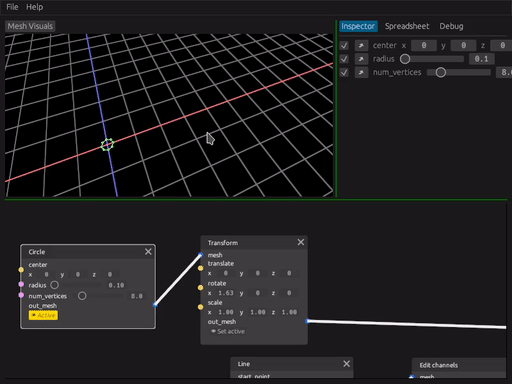Your Rusty 🦀 procedural 3d modeler
Blackjack is a procedural modelling application, following the steps of great tools like Houdini or Blender's geometry nodes project. At its core, Blackjack is a simple node-driven interface where you can compose operations to create a 3d mesh in a non-destructive way.
Blackjack does not aim to replace an industry powerhouse such as Houdini. Instead, it aims to provide a less cluttered, more robust and user-friendly experience for a small subset of the features that make these tools a great fit in the world of game development and real-time simulations.
Here are the main goals and philosophy behind blackjack, but note that this shows the direction where things are going, not their current state.
- Procedural polygonal modelling, first and foremost: The main focus in Blackjack is the creation of low-poly procedural assets like the ones one would see in videogames. In particular, surface extraction of volumetric data is not among its goals.
- Flexible node-based interface: Build complex node graphs, create reusable functions, and tweak every parameter in real-time!
- Integration with popular game engines: Export your procedural assets as tiny programs and tweak their parameters at runtime by adding a simple library to your engine of choice.
- Error resilience, crash resistance: When things go wrong, Blackjack will make an effort to respect your time as a user and not lose your work. Errors will be clearly communicated and fixing any bugs leading to a crash will take the highest priority.
Note: A crates.io version cannot be published due to unreleased dependencies. Blackjack depends on the bleeding edge version of some crates and requires custom forks for some others. This situation may change once development stabilizes.
Here are the steps in order to try out the early development version of Blackjack. Binaries and easier installation methods will be provided in the future. The steps below require a complete Rust toolchain using cargo, with a minimum supported Rust version (MSRV) of 1.62.0.
- Clone this repository, and make sure to download LFS files. In some systems, this may require separately installing a
git-lfs1 package:
git clone https://github.com/setzer22/blackjack
git lfs install
git lfs fetch --all
git lfs pull- Install build dependencies. This may not cover everything, please file an issue or a pull request if you find anything missing:
- Ubuntu/Debian:
sudo apt install libfontconfig-dev - Arch Linux:
sudo pacman -S fontconfig - Fedora:
sudo dnf install fontconfig-devel
- Ubuntu/Debian:
Note: The
fontconfignative dependency is temporary, and will no longer be necessary once this upstream issue is fixed: rust-windowing/winit#2373
- From the same folder, run
cargo run --release --bin blackjack_uito launch Blackjack.
Some minimal usage instructions. Please do note that these can and will change frequently during early development:
- The bottom section of the screen is the node graph.
- Use right click to open the node selector. Find a node and spawn it by clicking on it. You can also use the search bar.
- Nodes can be dragged around, and its widgets interacted with using the mouse.
- Dragging the mouse between two nodes' ports will create a connection.
- Use the 'Set active' button under a node to make it render to the screen.
Blackjack is built using Rust 🦀 and stands on the shoulders of giants. Here's a shout out to some great rust crates being used in this project:
- rend3 is used for all rendering purposes.
- egui is used as the UI toolkit powering all 2d interaction.
- wgpu, as the base of
rend3, is used for all custom visual effects. - mlua is used to integrate Luau as an extension language.
Blackjack is still under active development. Many features are missing and are bound to change. For now, no promises are made with regards to stability, but API breakage will be considered only when absolutely necessary.
Contributions are welcome! Before writing a PR, please get in touch by filing an issue 😄
Footnotes
-
Linux users can install
git-lfswith their distro's package manager (apt install git-lfs/yum install git-lfs/pacman -S git-lfs). MacOS users using homebrew can usebrew install git-lfs. Other users should follow the git-lfs install instructions. ↩





